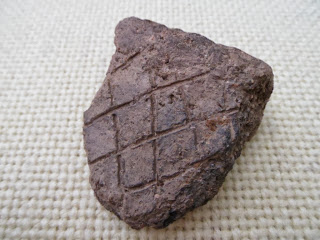A day of sunshine and showers. We also reached the bottom by which we mean we have reached
subsoil or 'natural' as we sometimes call it, i.e. the glacial till. The till is the sediment (clay, sands, gravels, stones) which was deposited by glaciers at the end of the last Ice Age about 11,000 years ago. All known human activity in Ireland post-dates this, therefore once we reach this level there is no reason to excavate any further. This is located at about 3.5m below the surface of the car park at this point. It is likely, however, given the slope of the hill, that the depth of the archaeology and the thickness of the overburden (i.e. garden soils, hardcore and gravel, etc.) is much less as you move 'up-slope' and towards Bishop Street.
Brian excavating down onto the subsoil which is a vivid orange-brown colour though it doesn't show up so well in this photo
We also recovered another
silver coin (bringing our total of silver coins to three) - a nice way to end the week! And lots more medieval pottery which we hope a medieval-pottery specialist will be able to look at next week. As we have now determined the depth of archaeology that survives, which was one of the main goals of the excavation, we are on target to finish up on site by the end of next week. We plan to complete excavation and recording by Wednesday after which we will start to reinstate the site and return it back to being a car park.
Today's sieving team - Volunteers John and Flavio and Grace (CAF)
Flavio (who is determined we find a wall, or possibly some eyeballs or even a penguin....)
Today the Fountain Primary school visited the site on their second visit though for one of the pupils it was his sixth visit!
the silver coin [not very photogenic]
some of the decorated medieval pottery found on site today





.JPG)
.JPG)
.JPG)
.JPG)
.JPG)
.JPG)


.JPG)






.JPG)
.JPG)
.JPG)
.JPG)
.JPG)
.JPG)
.JPG)
.JPG)

.JPG)
.JPG)
.JPG)

.JPG)
.JPG)
.JPG)
.JPG)
.JPG)


.JPG)

.JPG)

.JPG)
.JPG)
.JPG)


.JPG)